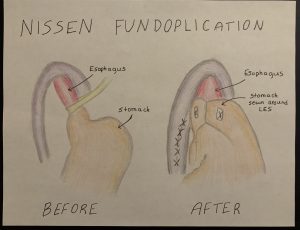
I did my project on GERD and a surgical procedure that is used as a common treatment option for it. In my drawing, the first illustration represents what the stomach and esophagus look like before. Here, the esophagus is on its own. In GERD, the lower esophageal sphincter isn’t functioning correctly, causing a back flow of food from the stomach. The second image shows what it looks like after the procedure. The stomach is wrapped around the lower portion of the esophagus and sewn shut, thus stabilizing the LES.

After reviewing Diana Fendel’s steam project, I found it very interesting. Especially how the nissen fundoplication procedure was shown in the illustration. Gastroesophageal reflux disease (GERD) is the condition that results when gastric material that refluxes into the esophagus or oropharynx causes symptoms, tissue injury, or both. Endoscopic examination usually is not required to determine GERD, but endoscopy is the best diagnostic test for Barrett’s esophagus, a form of GERD that lead to esophageal adenocarcinoma. Patients found to have Barrett’s esophagus will need regular endoscopic surveillance for early neoplasia. Esophageal pH monitoring is useful for patients who have symptoms or signs suggestive of GERD, but who have little or no response to antisecretory therapy. For patients who have severe, ulcerative reflux esophagitis, the clinician has only two reasonable therapeutic options: (1) lifelong antisecretory therapy with proton pump inhibitors or (2) antireflux surgery.
Nissen fundoplication is the procedure of choice for gastroesophageal reflux. Because of the increasing trend in laparoscopic surgery and the advanced instruments available, laparoscopic Nissen fundoplication procedures are now performed on a routine basis. One advantage of laparoscopic Nissen fundoplication is that the laparoscopic approach is far less presumptuous. With an open Nissen fundoplication, the hospital stay is about 3 to 5 days. Because of the large midline incision, a recovery time of 4 to 6 weeks is required. The patient can resume daily activities sooner with little pain associated with laparoscopic Nissen fundoplication and the overall hospital bill is less because of the less amount of days spent in the hospital for postoperative recovery.